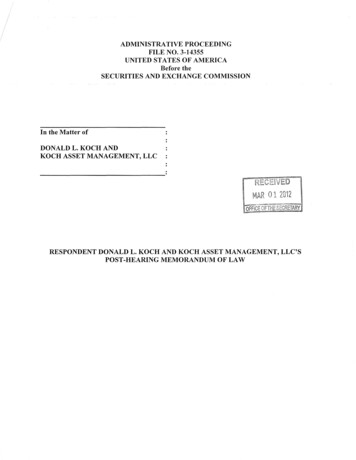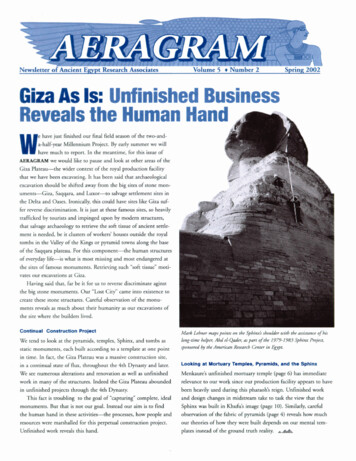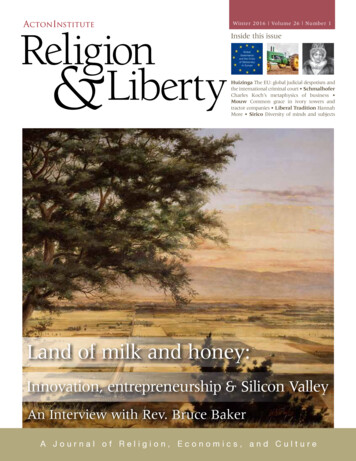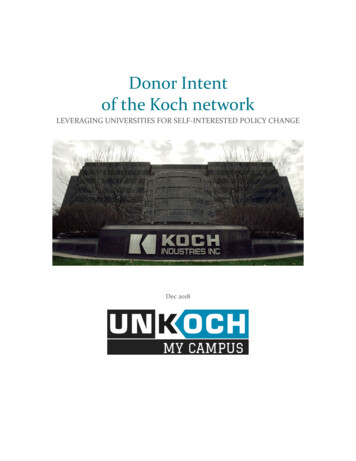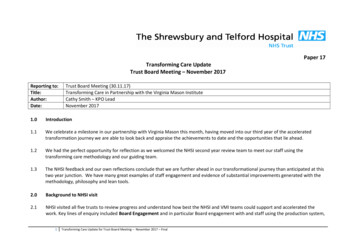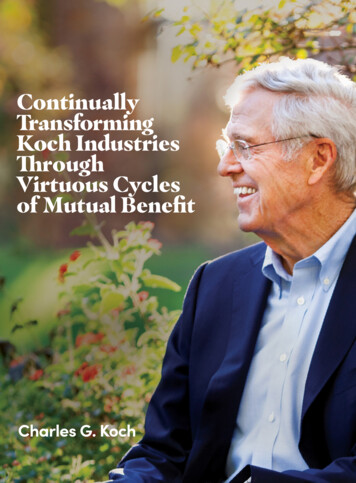
Transcription
ContinuallyTransformingKoch IndustriesThroughVirtuous Cyclesof Mutual BenefitCharles G. Koch
I was introduced to hard work at an early age, including pitchinghay when I was six. 2020 Koch Industries, Inc. All rights reserved.No part of this book may be reproduced in any form or by any electronic or mechanical means, includinginformation storage and retrieval systems, without the permission of Koch Industries, Inc.
ContentsINTRODUCTIONFounded on PrinciplesSECTION 1Understanding Virtuous Cycles of Mutual BenefitSECTION 2From Distillation Trays to Engineered SolutionsSECTION 3Gathering, Trading & DistributionSECTION 4Chemical Process IndustriesSECTION 5InvestmentsSECTION 6Electronic & Data TechnologySECTION 7Fostering A Republic of ScienceCONCLUSION18213040515867As Simple as Possible, but No Simpler74Appendix79
INTRODUCTIONFounded onPrinciplesIN THIS SECTIONKoch’s Framework for SuccessSelf-ActualizationBeing Contribution MotivatedWe needed just two floors of a downtown officebuilding to house a significant fraction of our 300employees when I came here in 1961. Today, KochIndustries has 130,000 employees worldwide.
FOUNDED ON PRINCIPLES“The man whograsps principles cansuccessfully selecthis own methods.The man who triesmethods, ignoringprinciples, is sure tohave trouble.”- HARRINGTON EMERSON
FOUNDED ON PRINCIPLESKOCH’S FRAMEWORK FOR SUCCESSOver the past six decades, Koch Industries has transformed from a small familyfirm with a narrow focus into one of the largest privately held companies inAmerica. Since 1960, we have entered dozens of new industries, added 130,000 employees and expanded into at least 60 countries — all while outperforming the S&P 500 bymore than 30-to-1. We now make everything from popular consumer brands to industrial commodities and are well-established in the world of technology-driven change.This booklet explains how and why Koch Industries has flourished and provides aguide for accomplishing much more. It illustrates how the focused application ofthe concepts and principles that make up Market-Based Management (MBM )transformed the entire trajectory of Koch Industries, helping us grow 7,000-fold.At its root, Market-Based Management is a framework designed to help organizationscreate virtuous cycles of mutual benefit, which we have accomplished by increasinglyand more systematically applying MBM.What is a virtuous cycle of mutual benefit? It is the process by which people andorganizations continuously build capabilities that create value for others, a neverending process that generates exponential growth. At Koch Industries, we haveachieved five such cycles: in engineered solutions; in gathering, trading and distribution; in chemical process industries; in investments; and, most recently, in electronicand data technology. (We are not a conglomerate, as our capabilities are inter-relatedand mutually reinforcing.) We have grown tremendously in each area by creatinggoods and services that help others improve their lives. Insofar as Koch Industrieshas succeeded, it is because we have enabled others to succeed.3
FOUNDED ON PRINCIPLESThese mutually beneficial cycles were created by those who first created their own.They did so as the company increasingly focused on building a culture in which peoplecould self-actualize. That is our goal for everyone here.SELF-ACTUALIZATION & BEING CONTRIBUTION MOTIVATEDSelf-actualization was defined by psychologist Abraham Maslow as realizing yourpotential — what he described as “everything one is capable of becoming.” Achievingthis requires discovering, developing and utilizing your innate abilities to live a lifeof meaning. Such people are contribution motivated, committed to helping othersimprove their lives, rather than being negatively motivated (like those who hoardknowledge or seek unfair advantages). When self-actualized people make a contribution to others and to society, it gives them such satisfaction that they strive to findfurther ways to contribute, leading to a lifetime of virtuous cycles. Self-actualizedindividuals willingly face reality, creatively solve problems and find fulfillment inhelping others succeed.Koch Industries’ transformations have always depended on our employees’self-transformation, according to these principles. For the company to continue toPsychologist Abraham Maslow stressed becoming “everything one is capable of.”4
FOUNDED ON PRINCIPLEScreate cycles of mutual benefit and succeed in this new world of rapid and fundamental change, we must continually improve our ability to enable our employeesto transform themselves. Employees who do so not only enable the company toflourish — they realize their potential and have much more successful, fulfilling lives.What you can be you must be.Self-actualization can involve a course correction anytime in life, as it did for me.Despite earning three degrees in engineering, I was a lousy engineer, so I searched foranother way to contribute. I found it by applying my conceptual aptitudes to learn theprinciples of scientific and social progress. I used these to develop a framework forbusiness and life based on the principles of mutual benefit and continual transformation. I’m living proof that you can succeed beyond your wildest dreams by diligentlydeveloping your abilities and using them to create value for others. The same is truefor people everywhere.Although most of these pages focus on examples involving Koch Industries, mymessage is universal. Whether we’re talking about an individual, an organization ora society, I am convinced that Maslow’s observation was spot-on: What you can be,you must be.Leaders at every level have an essential role in fostering a culture of self-actualization.Effective leaders not only live by our Guiding Principles (see Appendix), they regularlyreview them with employees and provide frequent and forthright feedback thatstimulates dialogue and change. They hold themselves and their organizationsaccountable for applying these Principles in a way that enhances self-actualization,leading to virtuous cycles of mutual benefit.While leaders are important in helping employees self-actualize, they cannot imposethat kind of transformation. Virtuous cycles, whether individual or organizational,can only occur from the bottom up, as individuals develop and apply their abilitiesand as organizations do the same with their capabilities. To become self-actualized,employees must internalize our Guiding Principles through study and regular5
FOUNDED ON PRINCIPLESOur expansion in the 1990s was dwarfed by the much greater transformations in theyears that followed.6
FOUNDED ON PRINCIPLESpractice until they can apply them instinctively. Self-actualization is the last Principlebecause it only comes about by internalizing the other seven Principles: Integrity;Stewardship and Compliance; Principled EntrepreneurshipTM; Transformation;Knowledge; Humility; and Respect. All are necessary for success — yours, mine, thecompany’s, and society’s.Koch Industries will continueto flourish only so long as youand I, as individuals, continuallydevelop and improve ourselves.We must all become lifelonglearners, committed to findingnew ways to contribute. Fortunately, since everyone has a gift,Newcomers to Koch, including college interns likewe all are capable of meaningful these, have more opportunity than ever before.contributions. With the right mindset and support, everyone can better themselvesby bettering others. I hope these pages will help inspire you to become the bestyou can be.We must all become lifelong learners,committed to finding new ways to contribute.KEY REFLECTIONS1 What is my unique gift? Am I developing and applying it?-2 Do I attempt to succeed by contributing or throughnegative behavior?3 Am I internalizing and practicing all theMBM Guiding Principles?7
SECTION 1UnderstandingVirtuous Cycles ofMutual BenefitIN THIS SECTIONEmployees’ RolePreferred PartnerContinual TransformationSources of FailureTo succeed long term, a business mustbecome a preferred partner and undergocontinual transformation.
UNDERSTANDING VIRTUOUS CYCLES OF MUTUAL BENEFIT“If there is notransformationinside us, all thestructural changein the world willhave no impact onour institution.”- PETER BLOCK
UNDERSTANDING VIRTUOUS CYCLES OF MUTUAL BENEFITEMPLOYEES’ ROLETo create virtuous cycles of mutual benefit, we need to understand their fundamentals and how each of us can contribute to them.These cycles begin when we develop capabilities that enable us to create value forothers. We apply these capabilities to serve the customers for whom we can createthe most value and who will reward us accordingly. We call these cycles virtuousbecause they benefit all the parties involved, from yourself to society.As we improve and apply our capabilities, new opportunities open, which point to theneed for additional capabilities. This leads to never-ending cycles of improvement,growth, and contribution to others.For an organization to create virtuous cycles, itmust have employees who create their own internal virtuous cycles. In other words, employeeswho are self-actualizing. Such people discovertheir innate abilities, develop them into valuedskills, apply them to maximize their y learn,grow, and contributeat a higher level.and then do it all over again. Individuals who follow this path — it is unique for eachperson — continually learn, grow, and contribute at a higher level, greatly increasingtheir ability to succeed, whatever their calling.Employees translate their personal cycles into organizational virtuous cyclesthrough two inter-related philosophies: becoming a preferred partner andcontinual transformation.10
UNDERSTANDING VIRTUOUS CYCLES OF MUTUAL BENEFITPREFERRED PARTNERA preferred partner is someone who prefers working with you rather than theiralternatives, because you do a superior job of providing what they value.At Koch Industries, we strive to become the preferred partner, not only of customers but of all our constituencies: employees, suppliers, communities, co-investors,regulators, and society. To achieve this, we: Provide customers with products and services they value more than their alternatives. By anticipating what customers’ alternatives will be, we can continue tocreate value for them in the future. Our preferred customers are those for whomwe can create superior value who compensate us accordingly. Help employees realize their potential. This is why we select, develop, reward,and retain employees based on their commitment to our Guiding Principles.The primary role for every supervisor is to ensure that employees develop theirinnate abilities into valued skills, have roles for which they have a comparativeadvantage, and are rewarded for the value they create. Choose suppliers who share our vision and values, and can and will create themost value for us. Develop a relationship that enables them to create more valuefor us than their other customers and reward them accordingly. Locate in communities with the laws, culture, capabilities, and geographiclocation that enable us to create the most value. Be dedicated to making thosecommunities a better place to live for everyone. Give preference to investment partners with aligned vision and values, andcomplementary capabilities. Strive to make the relationship mutually beneficialby helping them succeed. Understand what regulators are trying to achieve and then cooperate with themin a philosophy of mutual benefit. Encourage them to implement regulationsin a way that helps rather than hinders people’s ability to create value for others.11
UNDERSTANDING VIRTUOUS CYCLES OF MUTUAL BENEFIT Benefit society by practicing good stewardship and improving our ability toconsume fewer resources, freeing those resources to satisfy other needs. Striveto remove barriers that prevent people from realizing their potential and urgeothers to do the same.In short, we want people to be better off because of what we do and how we do it.When we create superior value for others (in whatever context), they choose topartner with us and enable us to build our capabilities and increase our contributions.Conversely, when we fail to provide superior benefits to our constituencies, theymay look elsewhere, which limits our ability to generate virtuous cycles. Preferredpartnerships are vital for progress.CONTINUAL TRANSFORMATIONSimilarly, continual transformation is alwaysand everywhere a necessity. The alternative isextinction. Our attitude — as a business and asindividuals — should be that however well weare doing, we can and must do much better atcreating value for others. This is the only way tosuccessfully deal with what Joseph Schumpeterdescribed as creative destruction. “Businessmen,”he said, are always “standing on ground crumblingbeneath their feet.”Given this reality, for an organization to succeedJoseph Schumpeter emphasizedthe concept of Creative Destruction.long term, it must have an effective vision — one that not only declares what it istrying to achieve, but provides a credible path toward that end. It must be realisticand based on the organization’s capabilities. At Koch, our Vision is our North Star.It’s not a destination. Rather, it is a constant guide and ever-present reminder of thepath we believe best fits us.12
UNDERSTANDING VIRTUOUS CYCLES OF MUTUAL BENEFITThe first paragraph of our Vision is as follows:“The role of business in society is to help people improve their livesby providing products and services they value more highly thantheir alternatives, and do so responsibly while consuming fewerresources. To the extent a business accomplishes this, its profitabilityis a valid measure of the value it creates in society.”A beneficial, well-articulated vision motivates employees to be productive andinnovative — but this will only happen if employees understand the particularvision that is relevant to their role, are committed to it, and are guided by appropriatemeasures. That is why we have made such an extensive effort to communicateKII’s Vision, which each business and capability should use to create their own.An effective vision enables employees to be self-directed and to fully utilize theirinnate abilities.Helping people improve their lives is fundamental to the role of business. To besuccessful long term, businesses must continually improve their products andservices, and do so responsibly and efficiently, providing ever-greater benefits toevery party involved. Only then will customers and others choose their offerings overthe many available alternatives.Successful businesses maximize the difference between the value they create fortheir customers and the value of those resources if consumed elsewhere. They alsodo their utmost to respect the rights of others.This commitment is reflected in more than just the quality of their products andservices. It requires creating a work environment in which the safety of employeesand others is the highest priority, the environment is protected, laws and regulationsare observed, and the temptation to corrupt the rules in hopes of profiting withoutcreating value for others is resisted.In our Vision, we stress the need to continually transform ourselves due to the realityof creative destruction. Although it threatens the very existence of long-standing jobs,13
UNDERSTANDING VIRTUOUS CYCLES OF MUTUAL BENEFITfirms, and industries, creativedestruction also creates exceptional opportunities. To give us abetter chance of capturing thoseopportunities, we need to fullyunderstand this dynamic.If the need to deal with creativedestruction was importantwhen Schumpeter wrote about italmost 80 years ago, it is exponentially more important today. Dueto the ever-more-rapid pace ofchange, we have a heightenedsense of urgency to transformour ability to create value and My own transformation resulted from focusingon my aptitudes and learning, and then applyingto use disruptive technologies abstract principles.when they will help us help others. All our people, businesses, and capabilities mustbecome more aggressive in creating virtuous cycles of mutual benefit.Our transformations are informed by knowledge networks within each business,throughout Koch, across our industries, and anywhere else that may be beneficial. These networks don’t just happen, they are continually built. In keepingwith our Republic of Science approach (see Section 7) we seek to understandtrends anywhere in the world — from any and all useful sources — that mightimprove, disrupt, or destroy what we do today. To ignore such developments isorganizational suicide.FAILURESAnother important source of knowledge is experimentation. To generate widespreadexperimentation, we cultivate a culture of prudent risk taking without penalizing thefailures that come from well-designed experiments. Successful experiments signal14
UNDERSTANDING VIRTUOUS CYCLES OF MUTUAL BENEFITus to move forward. Unsuccessful ones tell us to change or stop, preventing muchlarger future losses. (Experimentation is just as, if not more, essential for individualself-actualization.)The five presidents of KII (so far) after the company became Koch Industries: (L-R) Bill Hanna,Sterling Varner, Charles Koch, Joe Moeller, Dave Robertson.Before undertaking any new venture or strategy, we need to demonstrate that wehave the capabilities to create superior value. Do we understand all the factors thatcan cause it to fail? Are we capable of dealing with them? Like Karl Popper, we believethat the only “genuine test of a theory is the attempt to falsify it.” This commitmentto identifying the flaws prior to any undertaking is an essential aspect of ourchallenge process.We are now more focused than ever on eliminating waste — anything that doesn’tcreate value. This is why we relentlessly innovate to use fewer resources andminimize our environmental footprint. Over the last five years we have reduced ourproduction-related waste by 16% and are recycling, recovering for energy or treating92% of it. Our businesses have also reduced CO2 emissions by nearly 10% duringthe past four years. Since 2013, we have implemented more than 1,200 pollutionprevention activities, for which the Environmental Protection Agency has repeatedlynamed Koch the first- or second-ranked company for such initiatives. This reflects15
UNDERSTANDING VIRTUOUS CYCLES OF MUTUAL BENEFITour commitment to mutual benefit: Using fewer resources and creating less waste isa win for us, the communities in which we operate, and society as a whole.It is also wasteful to continue operating businesses when we are no longer able tocreate new virtuous cycles. This not only wastes our capital but the creative energyof our people, which is why we exit such businesses as soon as feasible.As we transform our businesses, they become more labor efficient. This means feweremployees will be required for any given role and each role will be more demandingand fulfilling, but involve less drudgery and hazards. The good news, as historyshows, is that this doesn’t increase overall unemployment. That’s because new jobsare created to produce the new products and services that replace the old. The hardpart is learning the new skills that will enable you to continue to contribute. The onlyanswer is to become a lifelong learner, which is a major reason we work so hard athelping our employees become self-actualized. A virtuous cycle will last only if weall continually learn, improve, and discover new opportunities to create value betterthan our competitors.Many of our virtuous cycles have ended. Other investments that we hoped wouldbecome virtuous cycles never materialized. The causes are varied. Sometimes it’sbecause of a failure of culture, a failure to continually innovate, superior innovationby others, or even outside influences beyond our control.We relentlessly innovate to usefewer resources and minimize ourenvironmental footprint.A prime example of all these factors is the story of my father’s thermal crackingprocess, which he developed in 1927. It helped independent refineries get higheryields, required less downtime and did not carry a royalty — all of which were majorbenefits to customers of Winkler-Koch Engineering. The business enjoyed a hugeuptick when the process was introduced, selling 15 installations in just two years.16
UNDERSTANDING VIRTUOUS CYCLES OF MUTUAL BENEFITBut the major oil companies, unhappy with this newfound competition fromindependent refiners, put an abrupt end to it by using their so-called Patent Clubto sue Winkler-Koch and its customers. Although the Patent Club eventually lostevery one of those cases (even after resorting to judicial bribery), the legal processtook more than a decade, making it difficult for a virtuous cycle to start. My father’sinvention probably wouldn’t have resulted in a virtuous cycle anyway, since no effortwas being made to develop new capabilities and catalytic cracking would soon replacethermal cracking.The process of creating virtuous cycles is seldom a journey of unmitigated successes.It is a trial-and-error process that results in setbacks and outright failures. Ourventures with chromatography systems, air quality consulting, dredge manufacturing,cryogenic systems, fiberglass pipe, and seawater desalination were all a bust. Theircommon denominator was our failure to properly apply the model of virtuous cyclesof mutual benefit. Instead, we overestimated our capabilities, misjudged opportunities, were unable to become a preferred partner, or did not build suitable knowledgenetworks. As you will see time and time again on the following pages, we had to learnsome difficult lessons the hard way — much as I have throughout my own life.Creating virtuous cycles is seldom a journeyof unmitigated successes.One of the most painful lessons hit us in the late 1990s when our success led to hubris,degenerating into destructive spirals. We gave MBM lip service rather than trulyapplying it. We stopped hiring on values first and began believing we could succeedat anything, regardless of whether we had the capabilities needed to create value.And it got worse from there.As is so often the case, these problems were rooted in our leadership, including me. Ihad been distracted by problems (including lawsuits) from several shareholders andneeded help to get the company back on track. In 1999, I finally got my head clear17
UNDERSTANDING VIRTUOUS CYCLES OF MUTUAL BENEFITenough to face the issues. My first step was persuading Joe Moeller to accept the roleof president and COO.Joe began dealing with the issues immediately, starting with the biggest: the seriousdeterioration of Koch Petroleum Group. Made up of the Pine Bend and Corpus Christiplants, as well as Koch Supply & Trading, KPG had long been an important contributorto Koch’s earnings and ability to create virtuous cycles.Everyone in our organization, regardless of role, is expected to learn and apply MBMto get results.Joe wisely selected Dave Robertson as KPG’s new leader. Dave had previously ledits sales group and was known and trusted by long-time employees. His approachwas to interview the KPG employees he felt would tell him the truth.18
UNDERSTANDING VIRTUOUS CYCLES OF MUTUAL BENEFITThose interviews revealed significant problems in all five dimensions of MBM:Vision — The group had stopped focusing on creating value for customers. Instead,it was engaged in financial fakery and organizational manipulation.Virtue and Talents — The senior leaders were not contribution motivated.They consistently violated our Guiding Principles. Meanwhile, good, long-termemployees were being pushed out.Knowledge Systems — Financial statements had become so complicated thatthey weren’t useful in guiding decisions. Business activities were divided into profitcenters which competed for credit and did not share knowledge. Challenge waspunished rather than rewarded.Decision Rights — The organization’s structure and authorities were so confusing that decisions took a long time or weren’t made at all.Incentives — The scorecards for each group were rigged to show that it wasperforming well and should be rewarded, even though it was not. Actual profitability was a fraction of the value represented.Based on these findings, the people causing the problems were quickly terminatedand the organizational structure was simplified, with clear accountability anddecision rights. The bogus scorecards were eliminated, and the financial statementsbegan reflecting reality. We made it clear that employees would only be rewardedif they created real value for our customers and the company — if they pursuedself-actualization, not stagnation.Following these essential changes, performance quickly rebounded and KPG’sprofitability greatly improved. Instead of a destructive downward spiral, KPG begancontributing to a virtuous cycle.As Dave Robertson put it, “Individuals working in the business both identifiedall the problems and came up with all the solutions. The fix was a bottom-upapproach recommended and implemented by team members committed to ourMBM philosophy.”19
UNDERSTANDING VIRTUOUS CYCLES OF MUTUAL BENEFITKEY REFLECTIONS1 Am I helping us become the preferred partner of ourconstituencies?-2 Am I looking for opportunities to improve my performancethrough continual transformation? Or am I content doingwhat I’ve always done?3 How can I better understand and apply the fivedimensions and Guiding Principles of MBM to spurmy own self-actualization?20
SECTION 2From DistillationTrays to EngineeredSolutionsIN THIS SECTIONOur First Virtuous CycleThe Perils of ProtectionismCustomers FirstKoch Engineering in the early 1960s lacked allthe elements of virtuous cycles.
FROM DISTILLATION TRAYS TO ENGINEERED SOLUTIONS“You will never changethings by fightingthe existing reality.To change something,build a new modelthat makes the existingmodel obsolete.”- BUCKMINSTER FULLER
FROM DISTILLATION TRAYS TO ENGINEERED SOLUTIONSOUR FIRST VIRTUOUS CYCLEIn 1961, the year I returned to Wichita, we had just two businesses of note: Rock IslandOil & Refining and Koch Engineering. RI owned a crude oil gathering system insouthwest Oklahoma that transported about 60,000 barrels of oil a day to a nearbymain line. KE, based in Wichita, made internals (called trays) for distillation towersat refineries and chemical plants. I had worked summer jobs for both businesses asa teenager.THE PERILS OF PROTECTIONISMWhen I was given responsibility for KE, I soon realized it was short-sighted, protectionist, difficult to deal with, and more than willing to keep doing the same thingsthe same old way. As a result, it failed to build capabilities that create value for others.Most customers bought our products because they didn’t have a better option, notbecause they were thrilled with us. We were no one’s preferred partner and sorelylacking in transformation of any kind. This situation came about largely due to myfather’s health.He was suffering from hypertension and heart ailments which left him with littlestrength and energy for office work, let alone building an effective management team.And although he was, in most ways, a tough, John Wayne type, he often couldn’t bringhimself to deal with problem employees.23
FROM DISTILLATION TRAYS TO ENGINEERED SOLUTIONSConsequently, the leaders for both RI and KE became self-protective and short-sighted.KE’s leader was an accountant who fretted over the cost of pencils. RI’s leader was ahard-drinking salesman who was willing to settle for whatever conditions the big oilcompanies wanted. They not only lacked vision, they were averse to change, with aprotectionist mentality. As a result, the company failed to focus on satisfying whatits customers valued, build needed capabilities and capture available opportunities.When my father put me in charge of KE, he told me I had free rein to do whatever Ithought was best, except selling it. Even with my limited experience (I had just turned26), I could see that big changes were required. Fortunately, I was too eager and toonaïve to be intimidated.When my father put me in charge of Koch Engineering, I knew big changes were required.Distillation trays are devices that separate liquids by differences in boiling points.Despite having a superior product, the FLEXITRAY valve tray, KE had managed to turnthis asset into a liability by being difficult to work with. Most of the large engineeringand operating companies had sophisticated engineering departments with a policyof checking product designs, but KE’s management refused to share our design calculations. Customers were also unhappy with our tendency to be late with deliveries,which extended the downtime at their plants. Many of those delays were because oursystems were poor. The Wichita office used an old IBM punch-card process that was24
FROM DISTILLATION TRAYS TO ENGINEERED SOLUTIONSoutdated even by 1960s standards. We were aboutsix months behind in our bookkeeping and therehad been no physical inventory of the plant for atleast two years. In short, we were slowly dying ofself-inflicted wounds.Our engineering business serving Europe andthe Middle East was in even worse shape; it waslosing money. Its leaders had decided to protectour manufacturing know-how by contractingdifferent tray components with multiple fabricators in various countries, so that none of oursuppliers could have the manufacturing knowledge to compete with us. This costly and complex Koch Engineering had a greatarrangement crippled our business overseas. Inproduct, but lacked customer focus.both Wichita and Europe, I could see that we had to do a much better and moreefficient job of creating value for our customers as they defined it.CUSTOMERS FIRSTOn the plus side, all these problems provided a ready-made laboratory for experimenting with
This booklet explains how and why Koch Industries has flourished and provides a guide for accomplishing much more. It illustrates how the focused application of the concepts and principles that make up Market-Based Management (MBM ) transformed the entire trajectory of Koch Industries, helping us grow 7,000-fold.
